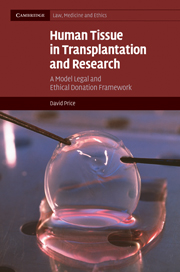Book contents
- Frontmatter
- Dedication
- Contents
- Preface
- Table of cases cited
- Table of selected statutory sources
- Introduction
- 1 Human biological materials
- 2 Interests in the living body and corpse
- 3 Eliciting wishes
- 4 Consent to donation
- 5 Presumed consent
- 6 Informed consent
- 7 Living donation
- 8 Property in human material
- Conclusion
- Index
- References
Conclusion
Published online by Cambridge University Press: 05 July 2014
- Frontmatter
- Dedication
- Contents
- Preface
- Table of cases cited
- Table of selected statutory sources
- Introduction
- 1 Human biological materials
- 2 Interests in the living body and corpse
- 3 Eliciting wishes
- 4 Consent to donation
- 5 Presumed consent
- 6 Informed consent
- 7 Living donation
- 8 Property in human material
- Conclusion
- Index
- References
Summary
It has been remarked that ‘The history of transplantation itself is rooted in the era of bodysnatching’. The legacy of non-consensual practices relating to both the living body and the corpse in the spheres of anatomical dissection and research are patent, in the latter case continuing right up to the present day. Differing perceptions of the ‘character’ of human tissue have come to drive a wedge between prevailing professional practices and contemporary expectations. The Retained Organs Commission remarked in its Final Report that ‘The research community struggled to see how what they regarded as work to advance medical science and promote better health could be wrong, whether or not it was done with consent. Human body parts, even human bodies, were perhaps to some scientists mere artefacts, no different from the instruments also utilised in their research.’ A seismic shift can now be seen, and a general crystallisation of the notion that individuals have a right to control the uses of tissues emanating from their living or dead bodies, reflected in the necessity for consent or authorisation. Audi contends that ‘There is, I think, a moral presumption that one’s relation to one’s body is so intimate that the body should not be invaded, even after one’s death, without at least one’s prior tacit consent or at worst the consent of relatives or friends who can be assigned to speak authoritatively for one’s interests (prior to death)’. This is a matter of fundamental principle with permissions being linked to specific purposes. O’Neill, for instance, states ‘Consent to removal of tissue for clinical reasons will not be viewed as entailing consent to its use for research’. The utility of the human body is now to be juxtaposed against notions of respect for persons. As the President’s Council on Bioethics stated ‘It is no exaggeration to say that our attitudes about organ transplantation say much about the kind of society that we are, both for better and worse’. The same may be said as regards research.
- Type
- Chapter
- Information
- Human Tissue in Transplantation and ResearchA Model Legal and Ethical Donation Framework, pp. 282 - 298Publisher: Cambridge University PressPrint publication year: 2009



